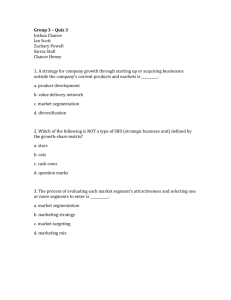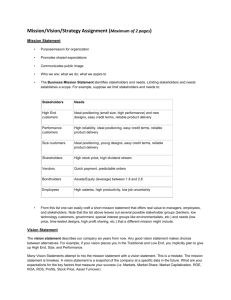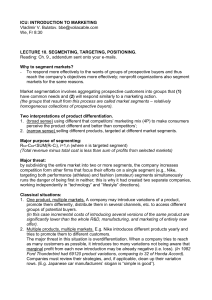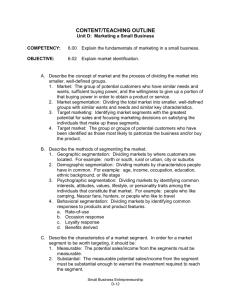Segmentation, Targeting and Positioning
advertisement
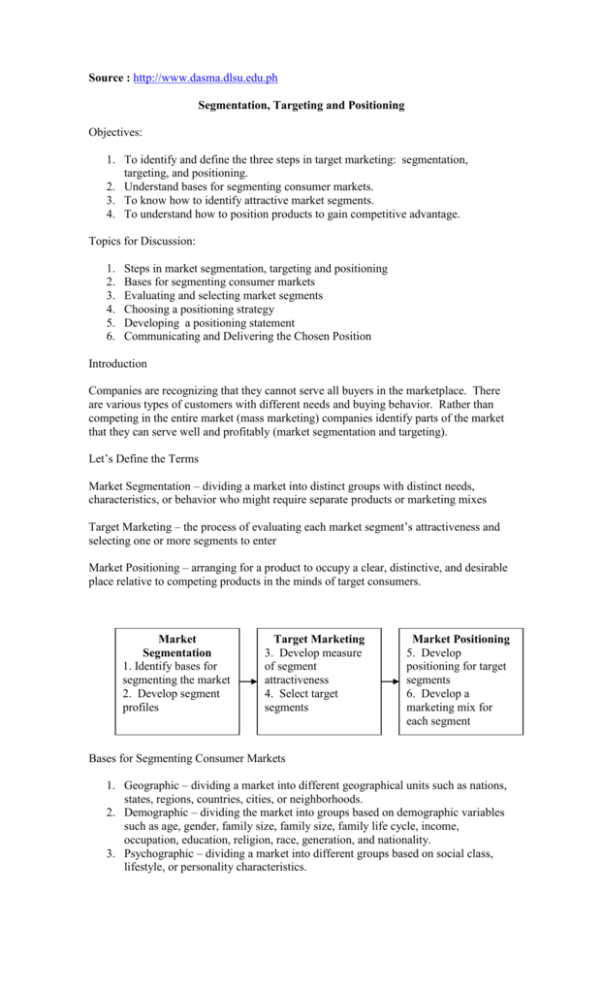
Source : http://www.dasma.dlsu.edu.ph Segmentation, Targeting and Positioning Objectives: 1. To identify and define the three steps in target marketing: segmentation, targeting, and positioning. 2. Understand bases for segmenting consumer markets. 3. To know how to identify attractive market segments. 4. To understand how to position products to gain competitive advantage. Topics for Discussion: 1. 2. 3. 4. 5. 6. Steps in market segmentation, targeting and positioning Bases for segmenting consumer markets Evaluating and selecting market segments Choosing a positioning strategy Developing a positioning statement Communicating and Delivering the Chosen Position Introduction Companies are recognizing that they cannot serve all buyers in the marketplace. There are various types of customers with different needs and buying behavior. Rather than competing in the entire market (mass marketing) companies identify parts of the market that they can serve well and profitably (market segmentation and targeting). Let’s Define the Terms Market Segmentation – dividing a market into distinct groups with distinct needs, characteristics, or behavior who might require separate products or marketing mixes Target Marketing – the process of evaluating each market segment’s attractiveness and selecting one or more segments to enter Market Positioning – arranging for a product to occupy a clear, distinctive, and desirable place relative to competing products in the minds of target consumers. Market Segmentation 1. Identify bases for segmenting the market 2. Develop segment profiles Target Marketing 3. Develop measure of segment attractiveness 4. Select target segments Market Positioning 5. Develop positioning for target segments 6. Develop a marketing mix for each segment Bases for Segmenting Consumer Markets 1. Geographic – dividing a market into different geographical units such as nations, states, regions, countries, cities, or neighborhoods. 2. Demographic – dividing the market into groups based on demographic variables such as age, gender, family size, family size, family life cycle, income, occupation, education, religion, race, generation, and nationality. 3. Psychographic – dividing a market into different groups based on social class, lifestyle, or personality characteristics. 4. Behavioral – dividing a market into groups based on consumer knowledge, attitude, use, or response to a product. a. Occasion – dividing the market into groups according to occasions when buyers get the idea to buy, actually make their purchase, or use the purchased item. b. Benefit – dividing the market into groups according to the different benefits that consumers seek from the product. Requirements for Effective Segmentation 1. Measurable – the size, purchasing power, and profiles of segments can be measured 2. Accessible – can be effectively reached and served 3. Substantial – large or profitable enough to serve 4. Differentiable – conceptually distinguishable and respond differently to different marketing mix elements and programs 5. Actionable – effective programs can be designed to attract and serve the segments Evaluating Market Segments There are three factors that a firm can use in evaluating different market segments. These are size and growth of the segment, segment structural attractiveness, and company objectives and resources. Segments that should be chosen are those with the right size and growth characteristics. However, the largest and fastest growing segments are not always the most attractive. The structural factors that affect attractiveness of a potential segment must also be examined. For example if there are already many companies serving the same segment then it becomes less attractive. Selecting Target Market Segments After evaluating the different segments the company decides which and how many segments to target. Target market - a set of buyers sharing common needs or characteristics that the company decides to serve The following are different levels of target marketing: 1. Undifferentiated Marketing or Mass Marketing – ignore different market segments and target the whole market with one offer 2. Differentiated Marketing or Segmented Marketing – a firm decides to enter different market segments and designs separate offers for each. 3. Concentrated Marketing or Niche Marketing – smaller than segments and may attract only one or few competitors 4. Micromarketing – tailoring products and marketing programs to suit the tastes of specific individuals and locations. Socially Responsible Target Marketing Controversy and concern arise when there are issues involved in targeting the vulnerable and disadvantaged segments such as children, the elderly, and the less educated with potentially harmful products such as cigarettes, liquor, and pornography. Bad case on targeting children was done by the telecoms while good case was done by Hapee toothpaste. Choosing a Positioning Strategy After deciding which segment/s to serve, the company must decide what positions it wants to occupy in the minds of those segments. Positioning involves implanting the brand’s unique benefits and differentiation in consumers’ minds. According to Al Ries and Jack Trout, positioning starts with a product. It is a piece of merchandise, a service, a company, an institution, or even a person. Positioning is not what you do to a product. It is what you do to the mind of the prospect. It is how you want your prospect to perceive your brand. According to Philip Kotler there are seven positioning strategies which are as follows: 1. On the specific product attributes. For example Toyota Corolla’s positioning strategy is “superior performance”, while Mitsubishi Lancer is “advance engineering”, and Nissan Sentra has “all power options 2. On the benefits offered. For example Colgate has “germ-killing action that fights gingivitis, Crest “reduces cavity” 3. According to usage occasions. Example: Motolite battery “good for the wet and dry season”, “tough and durable to long trips”, “pangmatagalan” 4. For certain classes. Example: J & J Baby shampoo “as one for adults makes your hair soft and gentle like a baby” 5. Directly against a competitor. Example: AVIS to Hertz – We’re no. 2 but we try harder 6. Directly away from competitors. Example: 7up the uncola 7. For different product class. Example: Margarine against butter and cooking oil Some cases of successful positioning strategies are Coca-Cola’s the Real Thing and Marlboro’s masculine position. Communicating the Positioning Strategy After you have decided on the positioning strategy for your brand you should communicate this to your target audiences: internal and external. The following are the important elements of communication: 1. The Message – must be in touch with reality. Nowadays advertisers use realitybased advertising. For instance never before were the words kili-kili, mabaho were used in TV commercials. It must be appealing to your target. If your target is teen don’t use kundiman jingles. 2. The Communicator – must be credible, must have a good reputation with no involvement in any scandal. Must not necessarily be a celebrity because oftentimes the focus is not centered on the product but on the celebrity 3. The Media – traditional such as TV, print, radio, are no longer the only options available. Non-traditional media such as billboards, transit, internet, etc. which are less expensive can be alternatives. 4. The Budget – should be proportionate to your expected sales
